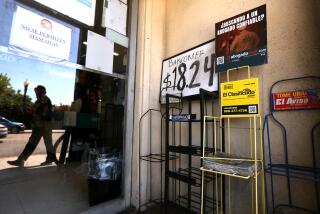This Latino superstore not quite in Santa Ana
- Share via
La Curacao, a 100,000-square-foot superstore that caters to Latino immigrants, is scheduled to open its doors this week in Fountain Valley, surprising some in Santa Ana who wondered why their heavily Latino city didn’t land the retail outfit.
In Santa Ana, “it’s all about how we can attract non-Hispanics, so I’m not surprised the store is in Fountain Valley,” said Sam Romero, who owns a Santa Ana religious-articles shop. “This is the center of the Hispanic community, and the store should be here.”
For years, Santa Ana’s city leaders have tried to reshape their immigrant city by bringing in more upscale restaurants and shops that attract a wider variety of people. Executives with La Curacao said they tried for three years to find a Santa Ana location before settling on adjacent Fountain Valley, which is only 10% Latino. At Fountain Valley City Hall, employees were still tongue-tied this week trying to say the store’s name (pronounced kurra-SOW).
Despite the store’s official address, La Curacao advertises itself as being in Santa Ana.
“We don’t have a problem with it,” said Fountain Valley city planner Robert Franklin.
“It will add to our sales tax revenue. We’re predominantly Anglo here, but in 10 years who knows what we will be.”
Critics say La Curacao, which offers immigrant shoppers instant credit, computer lessons and shipping to Mexico and Central America, belongs in Santa Ana, where 76% of the population is Latino and a greater percentage of people speak Spanish than in any other large city in the United States.
Elsa Gomez, president of the 4th Street merchants group, said shoppers were even searching Santa Ana for the new store.
“Everybody is looking for it,” Gomez said. “I’ve had more than 15 people ask me and I say, ‘Aqui no esta [It’s not here].’ The city is ... not thinking of the business advantages. We missed out. This would have encouraged competition and helped our downtown.”
Sal Tinajero, who was recently elected to the Santa Ana City Council, said Fountain Valley would “gain the benefits of the buying power of our residents. We needed it more. I believe our past leadership in Santa Ana has always tried to not create waves with the wealthier community in our city. That makes it difficult for a Latino-focused vendor to come in.”
A representative of Santa Ana Mayor Miguel A. Pulido said he declined to comment.
Councilman Jose Solorio lamented the loss of revenue for the city but said Santa Ana “is so built-out” that it’s hard to accommodate businesses needing large spaces.
He pointed out that another Santa Ana retailer, Famsa, a Mexican-based company, opened an appliance and electronics store in Santa Ana four years ago that quickly became among the most successful of its stores in the United States.
Famsa also sends merchandise to customers’ relatives in Mexico.
La Curacao, which took over the location of a closed Kmart, is the seventh store opened by the Los Angeles-based chain known for its loyal customers.
The store sends merchandise to even the smallest villages from its distribution centers in Mexico and Central America.
It also offers money transfers and home mortgage services, as well as local and long-distance telephone service, and a children’s play area with supervision.
La Curacao features its own credit card with a 24% interest rate and approves 75% of credit card applications regardless of the shoppers’ immigration status, company officials said.
The store uses unconventional techniques to determine credit risk, such as family connections in the area and number of roommates.
Carlos Avilas, a 42-year-old construction worker who lives in Costa Mesa, stopped at the store Tuesday but learned it’s scheduled to open later this week.
“I will always shop here,” Avilas said. “La Curacao gave me my first credit in the United States when no one else would. There’s no other store around like it, especially around here.”
*
More to Read
Inside the business of entertainment
The Wide Shot brings you news, analysis and insights on everything from streaming wars to production — and what it all means for the future.
You may occasionally receive promotional content from the Los Angeles Times.










